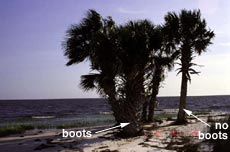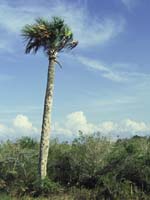Gulf of Mexico Tidal Wetlands
A Photo Gallery of Florida's Big Bend Tidal Wetlands
|
|
||||||||||||||||||||||||||||||||||||||||||||
|
||||||||||||||||||||||||||||||||||||||||||||
|
|
Sabal Palm
 sabal palms |
 burned and "bootless" sabal palms |
 lone sabal palm |
The sabal palm takes several forms, depending on age, fire, and storm history. As the tree grows, old leaf bases may remain on the trunk. These old leaf bases are called "boots." The "boots" typically found on younger trees may be removed by fires or storms.
In spite of differences in shape and size, the sabal palm can be identified by the "curving" rib in the center of each frond. This lone sabal palm (at right) is surrounded by buttonwood, a mangrove species found in infrequently flooded sites.
